Decoding Cytokine Dynamics: Wharton’s Jelly Stromal Cells and Chondro-Differentiates in PHA-Stimulated Co-Culture
Abstract
1. Introduction
2. Materials and Methods
2.1. Protocol Registration Details
2.2. Isolation of Mesenchymal Stem Cells from Wharton’s Jelly of Umbilical Cord by Explant Method
2.3. Immunophenotyping of MSCs Derived from Wharton’s Jelly (WJ)
2.4. Differentiation Potential of MSCs Derived from Wharton’s Jelly
2.5. Co-Culturing of Chondrogenic Differentiated WJ-MSCs with MNCs in Non-Activated and PHA-Activated Conditions
2.6. Quantitative Protein Expression Studies by Solid-Phase Sandwich Enzyme-Linked Immunosorbent Assay (ELISA)
2.7. Statistical Analysis
3. Results
3.1. Isolation and Morphological Characterization
3.2. Immunophenotypic Analysis
3.3. Tri-Lineage Differentiation
3.4. Chondrogenic Differentiation and Gene Expression
3.5. Influence of PHA Activation on Morphological Changes During Co-Culture of WJ-MSC-Derived Chondrocytes with MNCs
3.6. Expression of Pro- and Anti-Inflammatory Cytokines When Chondrocytes Crosstalk with Immune Cells Under PHA Stimulation
3.7. ELISA Quantification of Angiogenic Growth Factor VEGF
4. Discussion
5. Conclusions
Author Contributions
Funding
Institutional Review Board Statement
Informed Consent Statement
Data Availability Statement
Conflicts of Interest
References
- Hsu, H.; Siwiec, R.M. Knee Osteoarthritis. In StatPearls; StatPearls Publishing: Treasure Island, FL, USA, 2024. [Google Scholar]
- Goldring, M.B.; Otero, M. Inflammation in Osteoarthritis. Curr. Opin. Rheumatol. 2011, 23, 471–478. [Google Scholar] [CrossRef] [PubMed]
- Robinson, W.H.; Lepus, C.M.; Wang, Q.; Raghu, H.; Mao, R.; Lindstrom, T.M.; Sokolove, J. Low-Grade Inflammation as a Key Mediator of the Pathogenesis of Osteoarthritis. Nat. Rev. Rheumatol. 2016, 12, 580–592. [Google Scholar] [CrossRef] [PubMed]
- Shin, C.S.; Lee, J.H. Arthroscopic Treatment for Osteoarthritic Knee. Knee Surg. Relat. Res. 2012, 24, 187. [Google Scholar] [CrossRef][Green Version]
- Anderson, D.E.; Rose, M.B.; Wille, A.J.; Wiedrick, J.; Crawford, D.C. Arthroscopic Mechanical Chondroplasty of the Knee Is Beneficial for Treatment of Focal Cartilage Lesions in the Absence of Concurrent Pathology. Orthop. J. Sports Med. 2017, 5, 2325967117707213. [Google Scholar] [CrossRef]
- Steadman, J.R.; Ramappa, A.J.; Maxwell, R.B.; Briggs, K.K. An Arthroscopic Treatment Regimen for Osteoarthritis of the Knee. Arthroscopy 2007, 23, 948–955. [Google Scholar] [CrossRef]
- Angele, P.; Docheva, D.; Pattappa, G.; Zellner, J. Cell-Based Treatment Options Facilitate Regeneration of Cartilage, Ligaments and Meniscus in Demanding Conditions of the Knee by a Whole Joint Approach. Knee Surg. Sports Traumatol. Arthrosc. 2021, 30, 1138. [Google Scholar] [CrossRef]
- Shankar, A.N.; Jeyaraman, M.; Jayakumar, T.; Jeyaraman, N.; Nallakumarasamy, A.; Pranav, N.G. Gel-Based Autologous Chondrocyte Implantation (GACI) in the Chondral Defects of the Knee: An Observational Study. Indian J. Orthop. 2023, 57, 1809–1818. [Google Scholar] [CrossRef]
- Bačenková, D.; Trebuňová, M.; Demeterová, J.; Živčák, J. Human Chondrocytes, Metabolism of Articular Cartilage, and Strategies for Application to Tissue Engineering. Int. J. Mol. Sci. 2023, 24, 17096. [Google Scholar] [CrossRef]
- Phull, A.-R.; Eo, S.-H.; Abbas, Q.; Ahmed, M.; Kim, S.J. Applications of Chondrocyte-Based Cartilage Engineering: An Overview. BioMed Res. Int. 2016, 2016, 1879837. [Google Scholar] [CrossRef]
- Armiento, A.R.; Alini, M.; Stoddart, M.J. Articular Fibrocartilage—Why Does Hyaline Cartilage Fail to Repair? Adv. Drug Deliv. Rev. 2019, 146, 289–305. [Google Scholar] [CrossRef]
- Liu, Y.; Shah, K.M.; Luo, J. Strategies for Articular Cartilage Repair and Regeneration. Front. Bioeng. Biotechnol. 2021, 9, 770655. [Google Scholar] [CrossRef]
- Katz, J.N.; Brownlee, S.A.; Jones, M.H. The Role of Arthroscopy in the Management of Knee Osteoarthritis. Best Pract. Res. Clin. Rheumatol. 2014, 28, 143. [Google Scholar] [CrossRef] [PubMed]
- O’Connor, D.; Johnston, R.V.; Brignardello-Petersen, R.; Poolman, R.W.; Cyril, S.; Vandvik, P.O.; Buchbinder, R. Arthroscopic Surgery for Degenerative Knee Disease (Osteoarthritis Including Degenerative Meniscal Tears). Cochrane Database Syst. Rev. 2022, 2022, CD014328. [Google Scholar] [CrossRef]
- Maleitzke, T.; Elazaly, H.; Festbaum, C.; Eder, C.; Karczewski, D.; Perka, C.; Duda, G.N.; Winkler, T. Mesenchymal Stromal Cell-Based Therapy—An Alternative to Arthroplasty for the Treatment of Osteoarthritis? A State of the Art Review of Clinical Trials. J. Clin. Med. 2020, 9, 2062. [Google Scholar] [CrossRef] [PubMed]
- Pers, Y.-M.; Ruiz, M.; Noël, D.; Jorgensen, C. Mesenchymal Stem Cells for the Management of Inflammation in Osteoarthritis: State of the Art and Perspectives. Osteoarthr. Cartil. 2015, 23, 2027–2035. [Google Scholar] [CrossRef] [PubMed]
- Xiang, X.-N.; Zhu, S.-Y.; He, H.-C.; Yu, X.; Xu, Y.; He, C.-Q. Mesenchymal Stromal Cell-Based Therapy for Cartilage Regeneration in Knee Osteoarthritis. Stem Cell Res. Ther. 2022, 13, 14. [Google Scholar] [CrossRef]
- Kong, L.; Zheng, L.-Z.; Qin, L.; Ho, K.K.W. Role of Mesenchymal Stem Cells in Osteoarthritis Treatment. J. Orthop. Transl. 2017, 9, 89–103. [Google Scholar] [CrossRef]
- Somoza, R.A.; Welter, J.F.; Correa, D.; Caplan, A.I. Chondrogenic Differentiation of Mesenchymal Stem Cells: Challenges and Unfulfilled Expectations. Tissue Eng. Part B Rev. 2014, 20, 596. [Google Scholar] [CrossRef]
- Le, H.; Xu, W.; Zhuang, X.; Chang, F.; Wang, Y.; Ding, J. Mesenchymal Stem Cells for Cartilage Regeneration. J. Tissue Eng. 2020, 11, 2041731420943839. [Google Scholar] [CrossRef]
- Chen, F.H.; Tuan, R.S. Mesenchymal Stem Cells in Arthritic Diseases. Arthritis Res. Ther. 2008, 10, 223. [Google Scholar] [CrossRef]
- Wang, G.; Xing, D.; Liu, W.; Zhu, Y.; Liu, H.; Yan, L.; Fan, K.; Liu, P.; Yu, B.; Li, J.J.; et al. Preclinical Studies and Clinical Trials on Mesenchymal Stem Cell Therapy for Knee Osteoarthritis: A Systematic Review on Models and Cell Doses. Int. J. Rheum. Dis. 2022, 25, 532–562. [Google Scholar] [CrossRef] [PubMed]
- Sarsenova, M.; Issabekova, A.; Abisheva, S.; Rutskaya-Moroshan, K.; Ogay, V.; Saparov, A. Mesenchymal Stem Cell-Based Therapy for Rheumatoid Arthritis. Int. J. Mol. Sci. 2021, 22, 11592. [Google Scholar] [CrossRef]
- Wojdasiewicz, P.; Poniatowski, Ł.A.; Szukiewicz, D. The Role of Inflammatory and Anti-Inflammatory Cytokines in the Pathogenesis of Osteoarthritis. Mediat. Inflamm. 2014, 2014, 561459. [Google Scholar] [CrossRef] [PubMed]
- Wang, M.; Yuan, Q.; Xie, L. Mesenchymal Stem Cell-Based Immunomodulation: Properties and Clinical Application. Stem Cells Int. 2018, 2018, 3057624. [Google Scholar] [CrossRef] [PubMed]
- Babu, G.S.; Badrish, Y.; Oswal, V.M.; Jeyaraman, N.; Prajwal, G.S.; Jeyaraman, M.; Muthu, S.; Khanna, M. Immunomodulatory Actions of Mesenchymal Stromal Cells (MSCs) in Osteoarthritis of the Knee. Osteology 2021, 1, 209–224. [Google Scholar] [CrossRef]
- Meenakshi Sundaram, R.; Kadapakkam Nandabalan, S.; Rupert, S.; Srinivasan, P.; Sankar, P.; Patra, B.; Verma, R.S.; Vennila, R.; Sathyanesan, J.; Rajagopal, S. Differential Immunomodulation of Human Mesenchymal Stromal Cells from Various Sources in an Inflammation Mimetic Milieu. Cytotherapy 2022, 24, 110–123. [Google Scholar] [CrossRef]
- Secunda, R.; Vennila, R.; Mohanashankar, A.M.; Rajasundari, M.; Jeswanth, S.; Surendran, R. Isolation, Expansion and Characterisation of Mesenchymal Stem Cells from Human Bone Marrow, Adipose Tissue, Umbilical Cord Blood and Matrix: A Comparative Study. Cytotechnology 2015, 67, 793–807. [Google Scholar] [CrossRef]
- Dominici, M.; Blanc, K.L.; Mueller, I.; Slaper-Cortenbach, I.; Marini, F.C.; Krause, D.S.; Deans, R.J.; Keating, A.; Prockop, D.J.; Horwitz, E.M. Minimal Criteria for Defining Multipotent Mesenchymal Stromal Cells. The International Society for Cellular Therapy Position Statement. Cytotherapy 2006, 8, 315–317. [Google Scholar] [CrossRef]
- Lohan, P.; Treacy, O.; Lynch, K.; Barry, F.; Murphy, M.; Griffin, M.D.; Ritter, T.; Ryan, A.E. Culture Expanded Primary Chondrocytes Have Potent Immunomodulatory Properties and Do Not Induce an Allogeneic Immune Response. Osteoarthr. Cartil. 2016, 24, 521–533. [Google Scholar] [CrossRef]
- Selmani, Z.; Naji, A.; Gaiffe, E.; Obert, L.; Tiberghien, P.; Rouas-Freiss, N.; Carosella, E.D.; Deschaseaux, F. HLA-G Is a Crucial Immunosuppressive Molecule Secreted by Adult Human Mesenchymal Stem Cells. Transplantation 2009, 87, S62. [Google Scholar] [CrossRef]
- Alahdal, M.; Duan, L.; Ouyang, H.; Wang, D. The Role of Indoleamine 2,3 Dioxygenase 1 in the Osteoarthritis. Am. J. Transl. Res. 2020, 12, 2322. [Google Scholar] [PubMed]
- Yen, B.L.; Hwa, H.-L.; Hsu, P.-J.; Chen, P.-M.; Wang, L.-T.; Jiang, S.-S.; Liu, K.-J.; Sytwu, H.-K.; Yen, M.-L. HLA-G Expression in Human Mesenchymal Stem Cells (MSCs) Is Related to Unique Methylation Pattern in the Proximal Promoter as Well as Gene Body DNA. Int. J. Mol. Sci. 2020, 21, 5075. [Google Scholar] [CrossRef] [PubMed]
- Li, P.; Ou, Q.; Shi, S.; Shao, C. Immunomodulatory Properties of Mesenchymal Stem Cells/Dental Stem Cells and Their Therapeutic Applications. Cell. Mol. Immunol. 2023, 20, 558–569. [Google Scholar] [CrossRef] [PubMed]
- Song, N.; Scholtemeijer, M.; Shah, K. Mesenchymal Stem Cell Immunomodulation: Mechanisms and Therapeutic Potential. Trends Pharmacol. Sci. 2020, 41, 653. [Google Scholar] [CrossRef] [PubMed]
- Li, H.; Dai, H.; Li, J. Immunomodulatory Properties of Mesenchymal Stromal/Stem Cells: The Link with Metabolism. J. Adv. Res. 2023, 45, 15–29. [Google Scholar] [CrossRef]
- Wu, X.; Jiang, J.; Gu, Z.; Zhang, J.; Chen, Y.; Liu, X. Mesenchymal Stromal Cell Therapies: Immunomodulatory Properties and Clinical Progress. Stem Cell Res. Ther. 2020, 11, 345. [Google Scholar] [CrossRef]
- Chen, X.; McClurg, A.; Zhou, G.-Q.; McCaigue, M.; Armstrong, M.A.; Li, G. Chondrogenic Differentiation Alters the Immunosuppressive Property of Bone Marrow-Derived Mesenchymal Stem Cells, and the Effect Is Partially Due to the Upregulated Expression of B7 Molecules. Stem Cells Dayt. Ohio 2007, 25, 364–370. [Google Scholar] [CrossRef]
- Voisin, C.; Cauchois, G.; Reppel, L.; Laroye, C.; Louarn, L.; Schenowitz, C.; Sonon, P.; Poras, I.; Wang, V.; Carosella, E.D.; et al. Are the Immune Properties of Mesenchymal Stem Cells from Wharton’s Jelly Maintained during Chondrogenic Differentiation? J. Clin. Med. 2020, 9, 423. [Google Scholar] [CrossRef]
- Zhang, Y.; Pizzute, T.; Pei, M. Anti-Inflammatory Strategies in Cartilage Repair. Tissue Eng. Part B Rev. 2014, 20, 655. [Google Scholar] [CrossRef]
- Liu, S.; Deng, Z.; Chen, K.; Jian, S.; Zhou, F.; Yang, Y.; Fu, Z.; Xie, H.; Xiong, J.; Zhu, W. Cartilage Tissue Engineering: From Proinflammatory and Anti-Inflammatory Cytokines to Osteoarthritis Treatments. Mol. Med. Rep. 2022, 25, 99. [Google Scholar] [CrossRef]
- Johnson, K.E.; Wilgus, T.A. Vascular Endothelial Growth Factor and Angiogenesis in the Regulation of Cutaneous Wound Repair. Adv. Wound Care 2014, 3, 647. [Google Scholar] [CrossRef] [PubMed]
- Bao, P.; Kodra, A.; Tomic-Canic, M.; Golinko, M.S.; Ehrlich, H.P.; Brem, H. The Role of Vascular Endothelial Growth Factor in Wound Healing. J. Surg. Res. 2008, 153, 347. [Google Scholar] [CrossRef] [PubMed]
- Eming, S.A.; Krieg, T.; Davidson, J.M. Inflammation in Wound Repair: Molecular and Cellular Mechanisms. J. Investig. Dermatol. 2007, 127, 514–525. [Google Scholar] [CrossRef]
- Duffy, A.M.; Bouchier-Hayes, D.J.; Harmey, J.H. Vascular Endothelial Growth Factor (VEGF) and Its Role in Non-Endothelial Cells: Autocrine Signalling by VEGF. In Madame Curie Bioscience Database [Internet]; Landes Bioscience: Austin, TX, USA, 2013. [Google Scholar]
- Ma, S.; Xie, N.; Li, W.; Yuan, B.; Shi, Y.; Wang, Y. Immunobiology of Mesenchymal Stem Cells. Cell Death Differ. 2013, 21, 216. [Google Scholar] [CrossRef]
- Tao, H.; Han, Z.; Han, Z.C.; Li, Z. Proangiogenic Features of Mesenchymal Stem Cells and Their Therapeutic Applications. Stem Cells Int. 2016, 2016, 1314709. [Google Scholar] [CrossRef]
- Arutyunyan, I.; Fatkhudinov, T.; Kananykhina, E.; Usman, N.; Elchaninov, A.; Makarov, A.; Bolshakova, G.; Goldshtein, D.; Sukhikh, G. Role of VEGF-A in Angiogenesis Promoted by Umbilical Cord-Derived Mesenchymal Stromal/Stem Cells: In Vitro Study. Stem Cell Res. Ther. 2016, 7, 46. [Google Scholar] [CrossRef]
- Beheshtizadeh, N.; Gharibshahian, M.; Bayati, M.; Maleki, R.; Strachan, H.; Doughty, S.; Tayebi, L. Vascular Endothelial Growth Factor (VEGF) Delivery Approaches in Regenerative Medicine. Biomed. Pharmacother. 2023, 166, 115301. [Google Scholar] [CrossRef]
- Chen, R.; Hao, Z.; Wang, Y.; Zhu, H.; Hu, Y.; Chen, T.; Zhang, P.; Li, J. Mesenchymal Stem Cell–Immune Cell Interaction and Related Modulations for Bone Tissue Engineering. Stem Cells Int. 2022, 2022, 7153584. [Google Scholar] [CrossRef]
- Han, Y.; Yang, J.; Fang, J.; Zhou, Y.; Candi, E.; Wang, J.; Hua, D.; Shao, C.; Shi, Y. The Secretion Profile of Mesenchymal Stem Cells and Potential Applications in Treating Human Diseases. Signal Transduct. Target. Ther. 2022, 7, 92. [Google Scholar] [CrossRef]
- Wang, Y.; Fang, J.; Liu, B.; Shao, C.; Shi, Y. Reciprocal Regulation of Mesenchymal Stem Cells and Immune Responses. Cell Stem Cell 2022, 29, 1515–1530. [Google Scholar] [CrossRef]
- Srinivasan, A.; Sathiyanathan, P.; Yin, L.; Liu, T.M.; Lam, A.; Ravikumar, M.; Smith, R.A.A.; Loh, H.P.; Zhang, Y.; Ling, L.; et al. Strategies to Enhance Immunomodulatory Properties and Reduce Heterogeneity in Mesenchymal Stromal Cells during Ex Vivo Expansion. Cytotherapy 2022, 24, 456–472. [Google Scholar] [CrossRef] [PubMed]
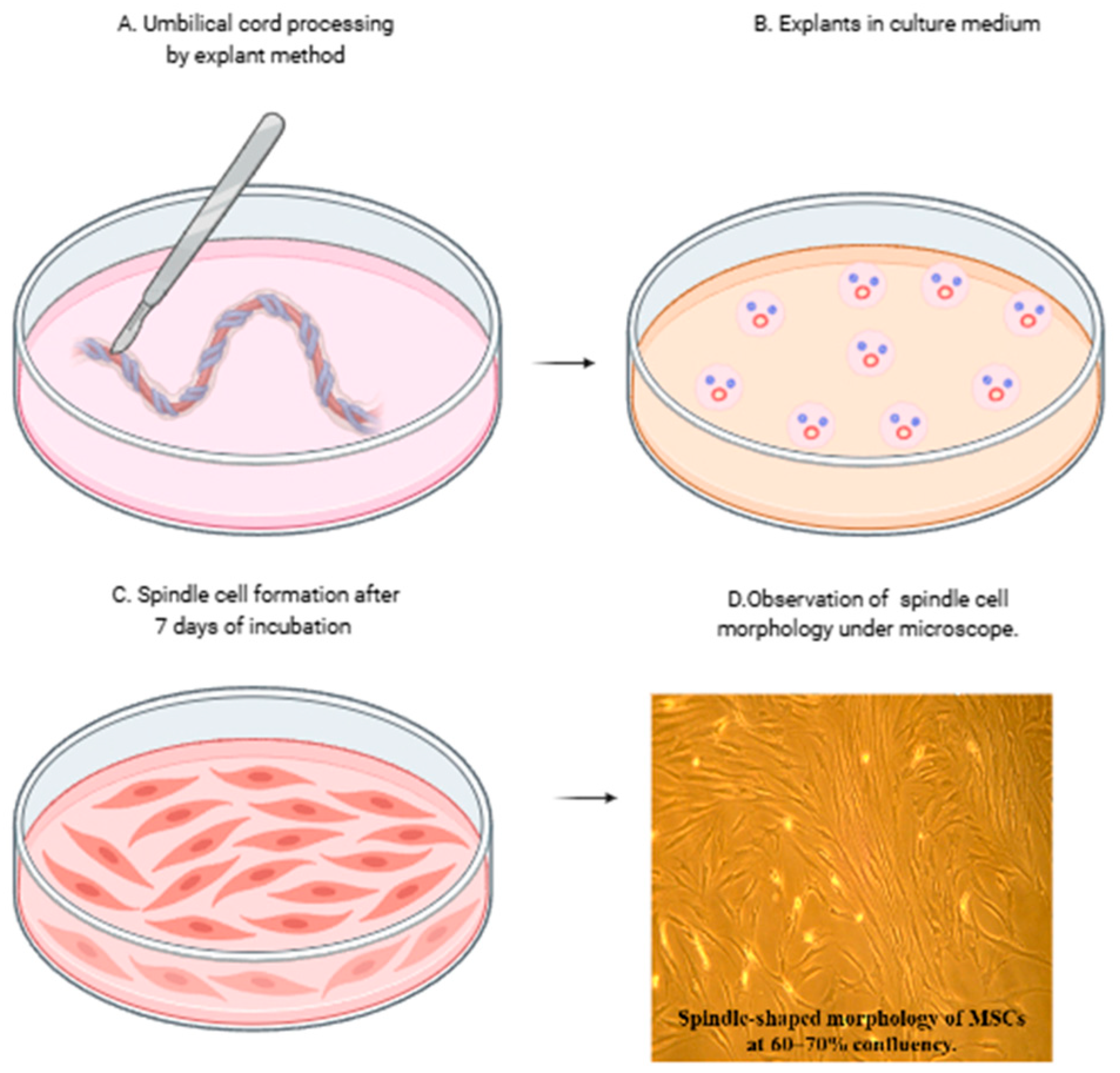
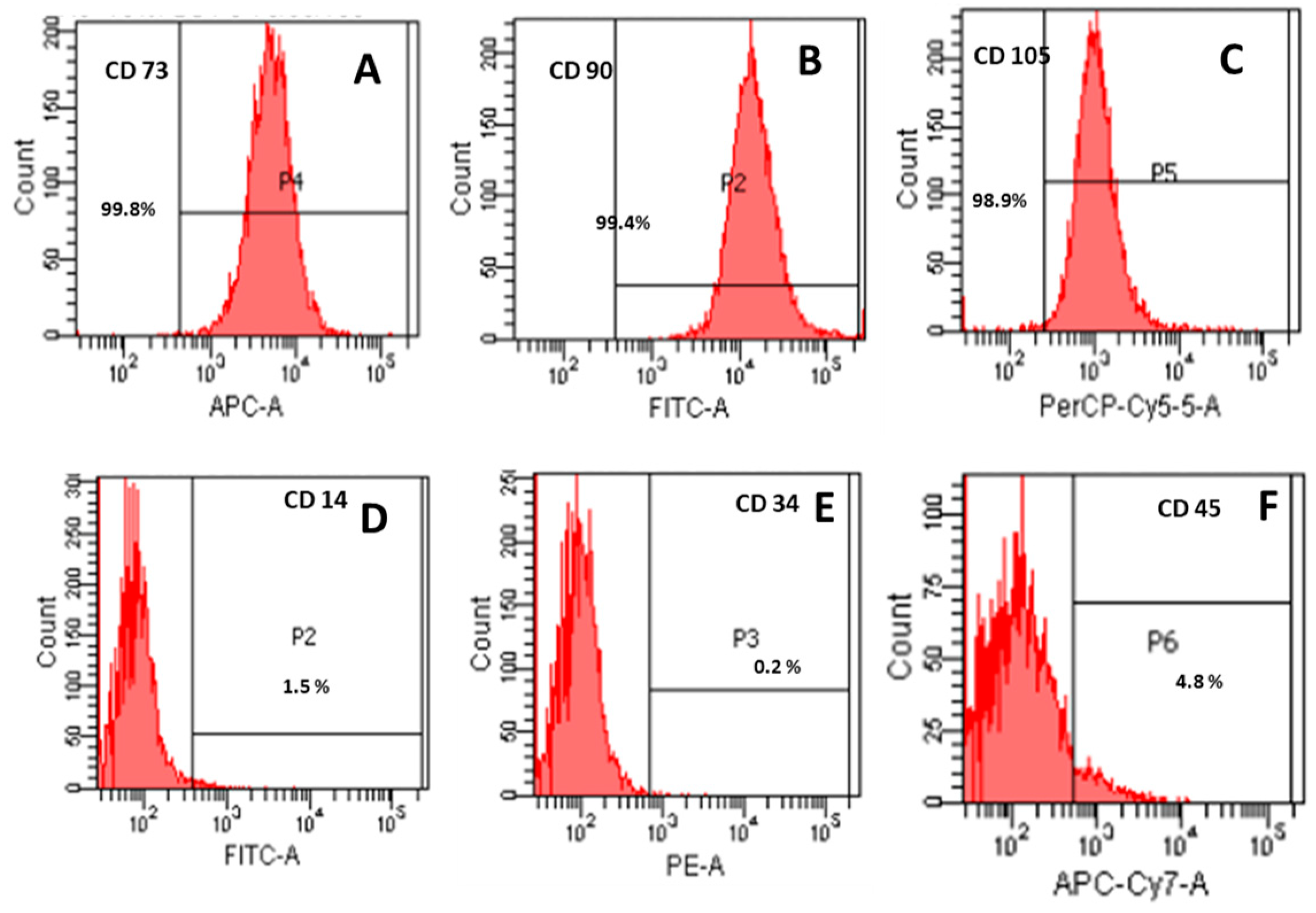
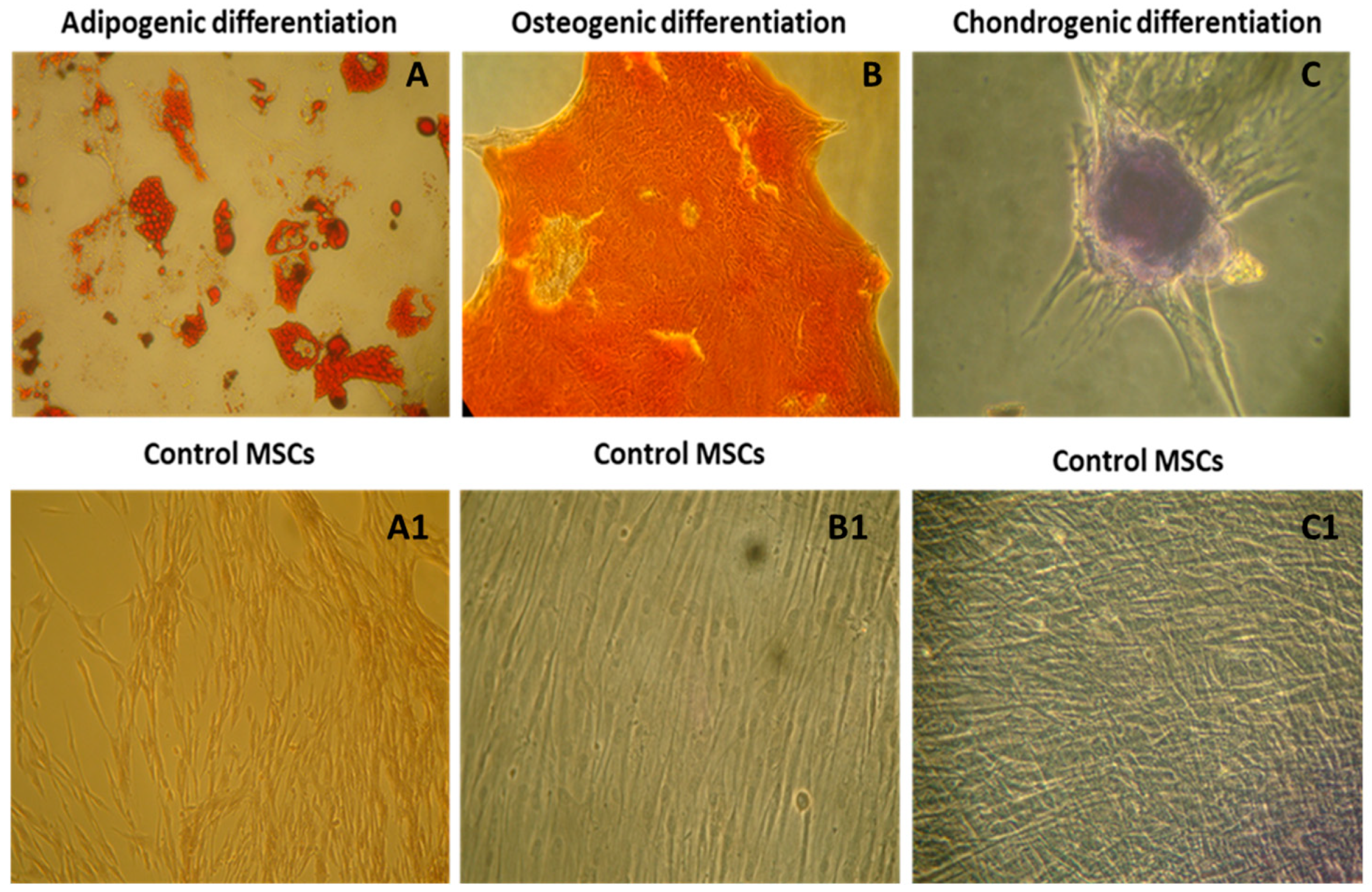
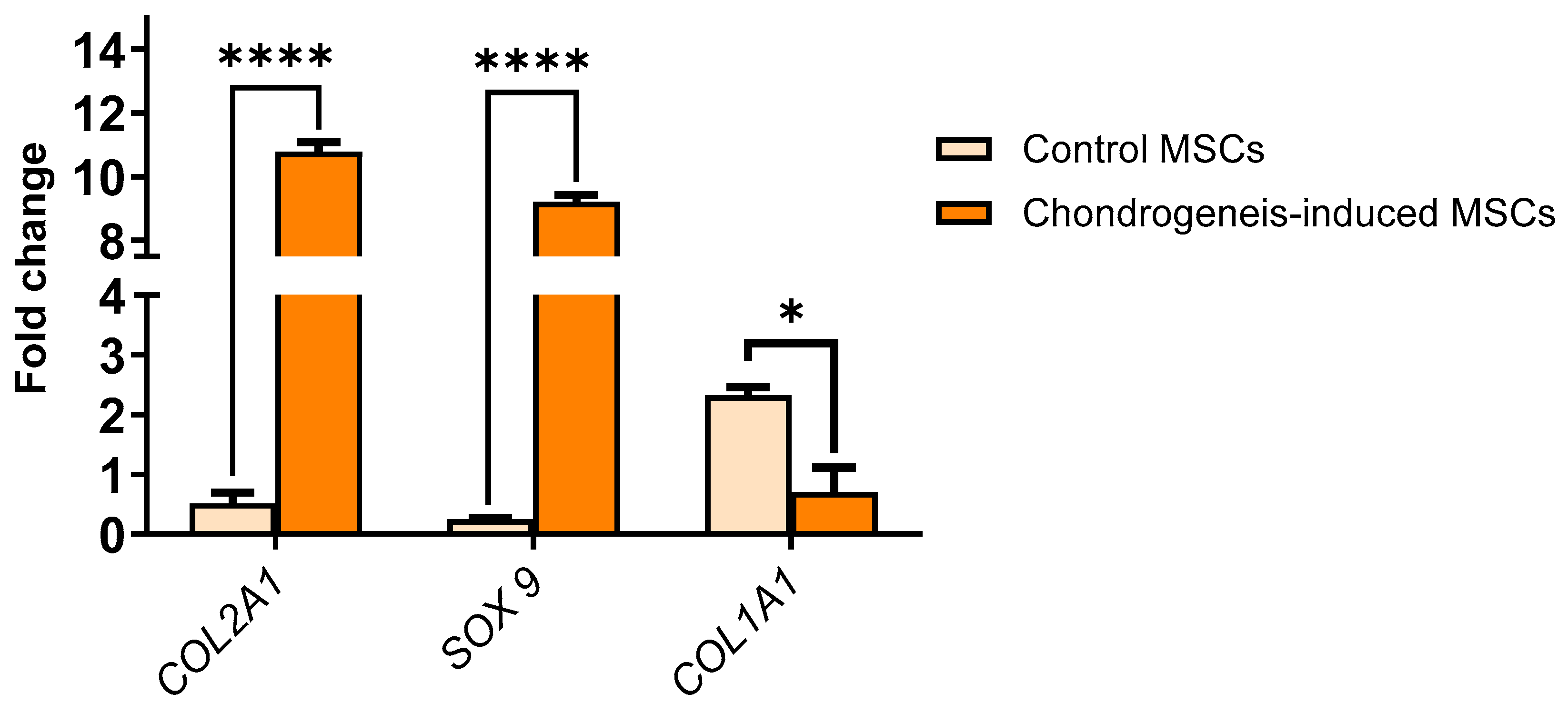
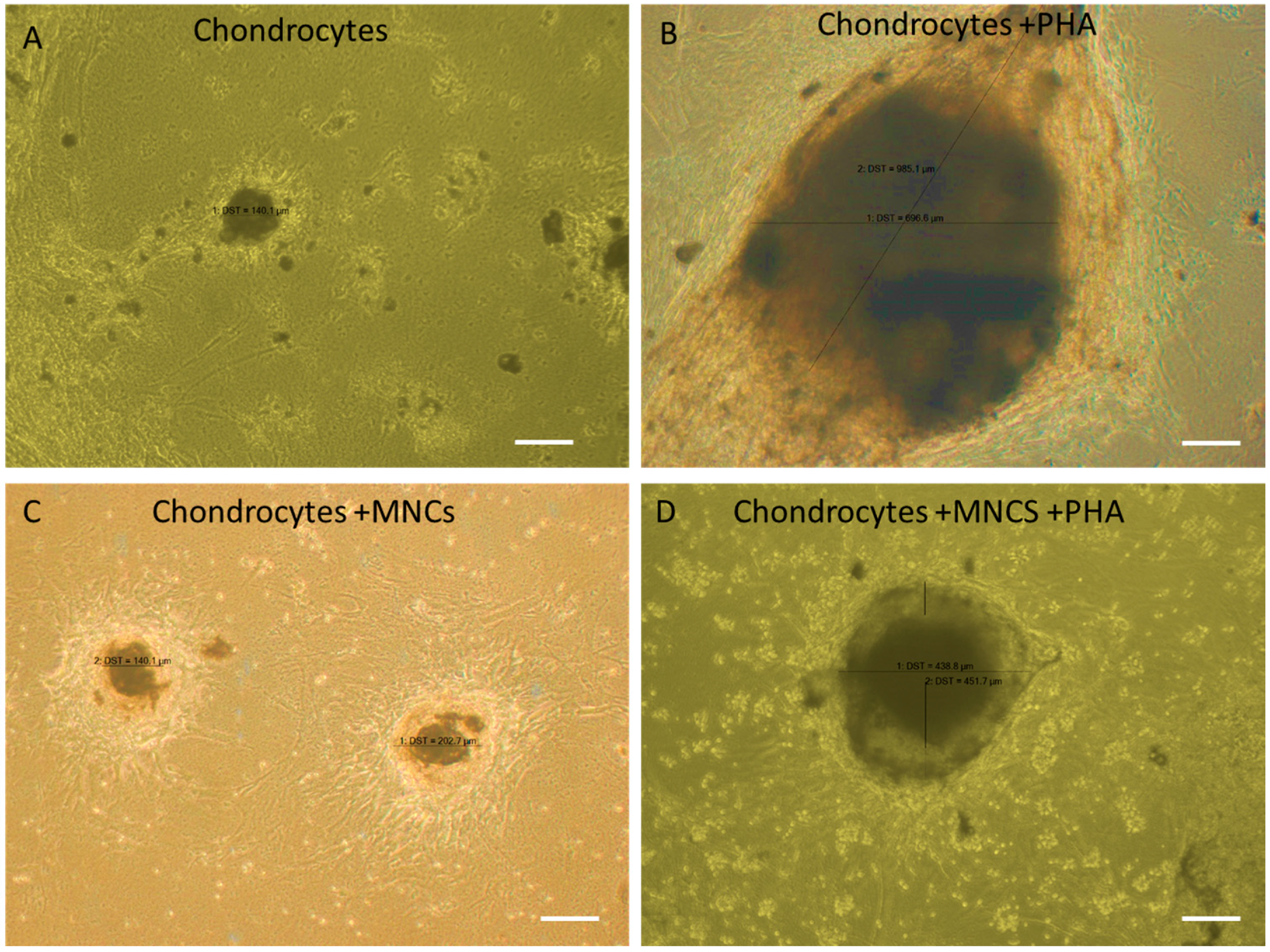
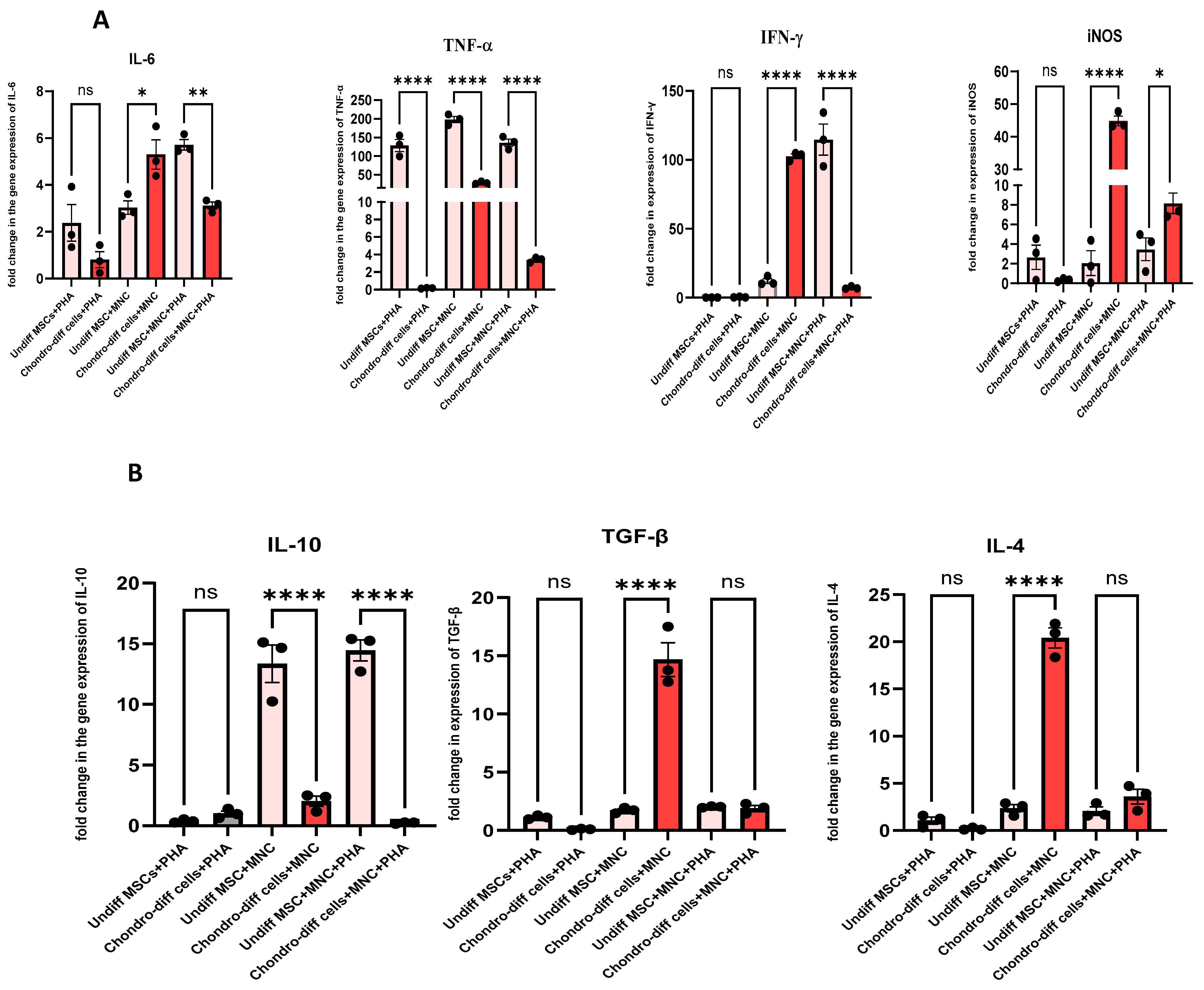
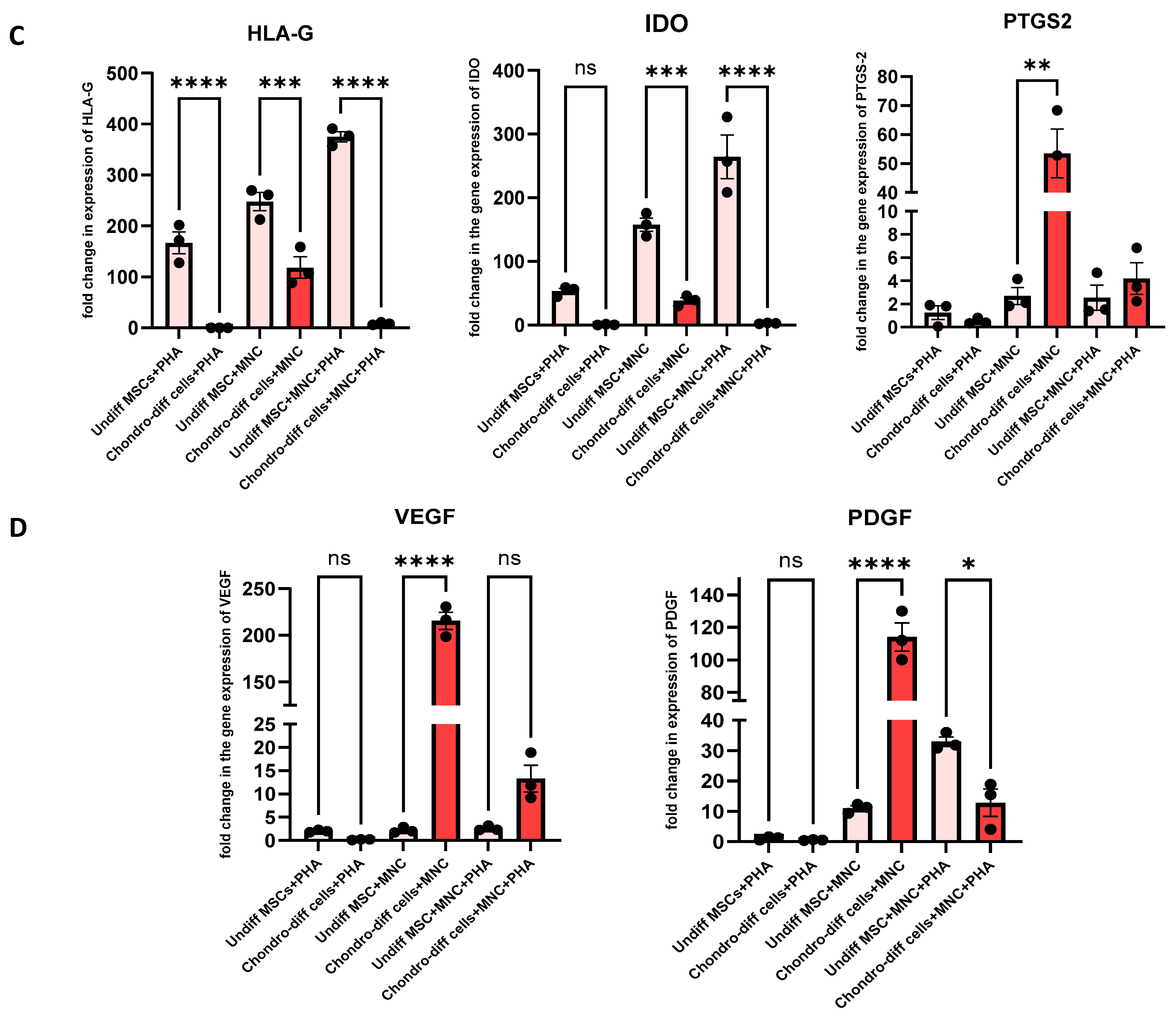
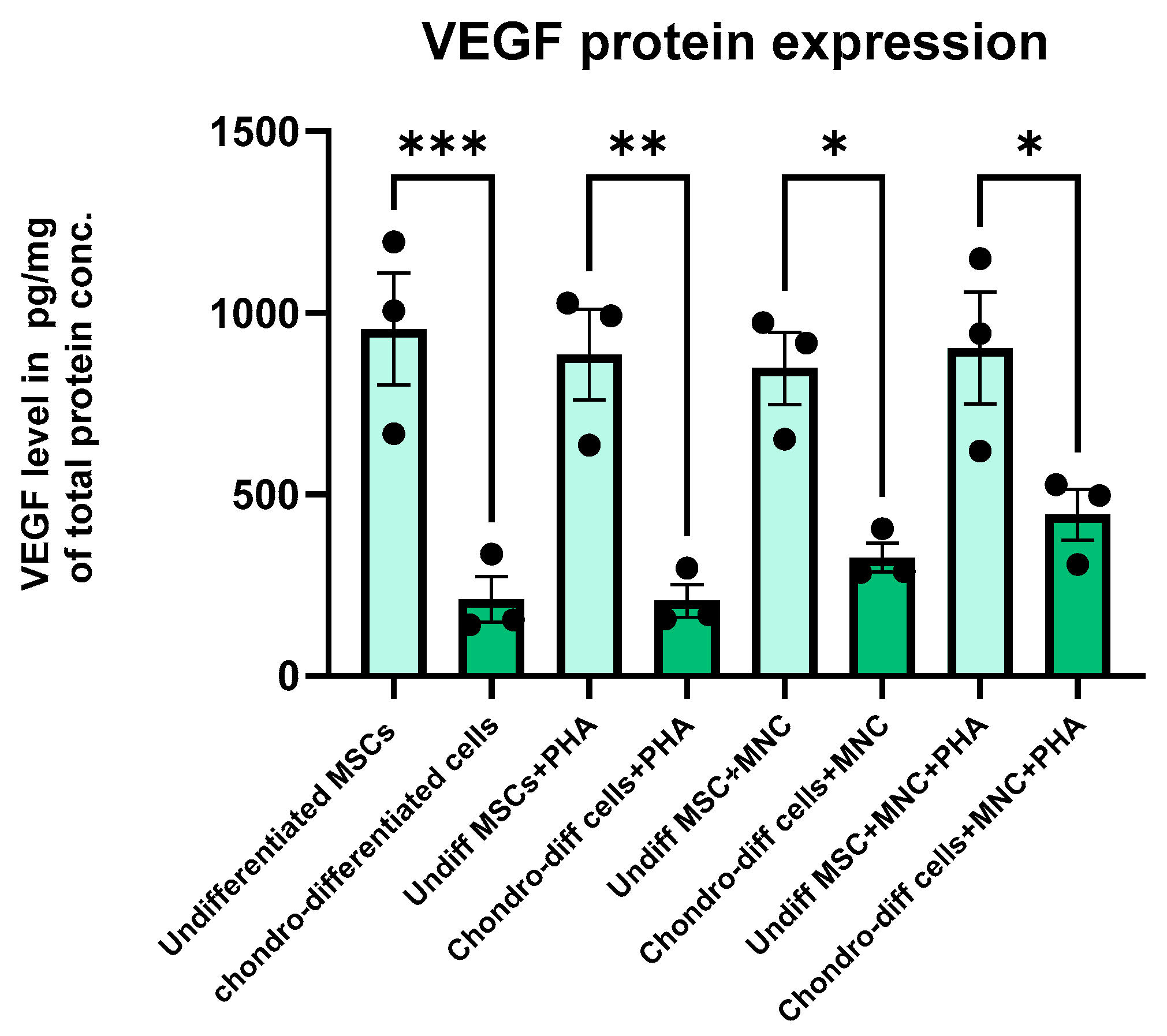
| Sl. No. | Cytokines | Gene Symbol | Gene Bank |
|---|---|---|---|
| 1 | Prostaglandin-endoperoxide synthase 2 | PTGS2 | NM_000963 |
| 2 | Transforming growth factor-beta 2 | TGFB2 | NM_003238 |
| 3 | Interferon, gamma | IFNG | NM_000619 |
| 4 | Interleukin 10 | IL-10 | NM_000572 |
| 5 | Interleukin 6 (interferon, beta 2) | IL-6 | NM_000600 |
| 6 | Interleukin 4 | IL-4 | NM_000589 |
| 7 | Platelet-derived growth factor-beta polypeptide | PDGFB | NM_002608 |
| 8 | Human leukocyte antigen G | HLA-G | NM_002127 |
| 9 | Indolamine 2,3 dioxygenase 1 | IDO | NM_002164 |
| 10 | Vascular endothelial growth factor | VEGF | NM_001025366 |
| 11 | Tumor necrosis factor | TNF-α | NM_000594 |
| 12 | Nitric oxide synthase 2, inducible | NOS2 | NM_000625 |
| 13 | B-actin | ACTB | NM_001101 |
| 14 | Human genomic DNA contamination | HGDC | Control |
| 15 | Positive PCR control | PPC | Control |
| 16 | Reverse transcription control | RTC | Control |
Disclaimer/Publisher’s Note: The statements, opinions and data contained in all publications are solely those of the individual author(s) and contributor(s) and not of MDPI and/or the editor(s). MDPI and/or the editor(s) disclaim responsibility for any injury to people or property resulting from any ideas, methods, instructions or products referred to in the content. |
© 2025 by the authors. Licensee MDPI, Basel, Switzerland. This article is an open access article distributed under the terms and conditions of the Creative Commons Attribution (CC BY) license (https://creativecommons.org/licenses/by/4.0/).
Share and Cite
Meenakshi Sundaram, R.S.; Rupert, S.; Srinivasan, P.; Sathyanesan, J.; Govarthanan, K.; Jeyaraman, N.; Ramasubramanian, S.; Jeyaraman, M.; Chung, H.Y.; Gangadaran, P.; et al. Decoding Cytokine Dynamics: Wharton’s Jelly Stromal Cells and Chondro-Differentiates in PHA-Stimulated Co-Culture. Cells 2025, 14, 174. https://doi.org/10.3390/cells14030174
Meenakshi Sundaram RS, Rupert S, Srinivasan P, Sathyanesan J, Govarthanan K, Jeyaraman N, Ramasubramanian S, Jeyaraman M, Chung HY, Gangadaran P, et al. Decoding Cytokine Dynamics: Wharton’s Jelly Stromal Cells and Chondro-Differentiates in PHA-Stimulated Co-Culture. Cells. 2025; 14(3):174. https://doi.org/10.3390/cells14030174
Chicago/Turabian StyleMeenakshi Sundaram, Raja Sundari, Secunda Rupert, Prasanna Srinivasan, Jeswanth Sathyanesan, Kavitha Govarthanan, Naveen Jeyaraman, Swaminathan Ramasubramanian, Madhan Jeyaraman, Ho Yun Chung, Prakash Gangadaran, and et al. 2025. "Decoding Cytokine Dynamics: Wharton’s Jelly Stromal Cells and Chondro-Differentiates in PHA-Stimulated Co-Culture" Cells 14, no. 3: 174. https://doi.org/10.3390/cells14030174
APA StyleMeenakshi Sundaram, R. S., Rupert, S., Srinivasan, P., Sathyanesan, J., Govarthanan, K., Jeyaraman, N., Ramasubramanian, S., Jeyaraman, M., Chung, H. Y., Gangadaran, P., & Ahn, B.-C. (2025). Decoding Cytokine Dynamics: Wharton’s Jelly Stromal Cells and Chondro-Differentiates in PHA-Stimulated Co-Culture. Cells, 14(3), 174. https://doi.org/10.3390/cells14030174









